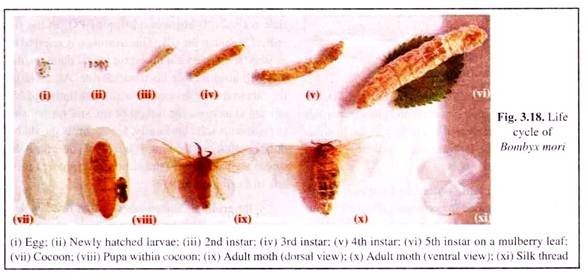Bombyx Mori Life Cycle

OURNAL OF INVERTEBRATE PATHOLOGY, 14, 316-320 (1969) The Life Cycle of Nosema bombycis as Revealed in Tissue Culture Cells of Bombyx morn REN ISHIHARA` Insect Pathology Research Institute, Sault Ste. Marie, Ontario, Canada Received March 31, 1969 Nosema bombycis spores inoculated into cultures of Bombyx mori cells resulted in infection of the cells.
Contents.Eri silk The common name, ailanthus silkmoth, refers to the host plant. There is a subspecies, S.
Cynthia ricini in India and Thailand that feeds upon the leaves of, and is known for the production of, and is often referred to by the common name eri silkmoth.The eri silk worm is the only completely domesticated silkworm other than Bombyx mori. The silk is extremely durable, but cannot be easily reeled off the cocoon and is thus spun like cotton or wool.
Ailanthus silkmoth diversity (with specimens included in first two rows) Eggs Whitish eggs, marked with brown, are laid in rows of 10 to 20 on leaves in crescents. Hatching takes 7–10 days.Larvae Larvae are and yellow at first. Later are solitary, and whitish green with white tubercules along the back, and small black dots.
There are five instars, and they reach a maximum length 70–75 mm.Pupae A silken off-white to grey cocoon is spun on the leaves of the host. It has an obvious escape hatch.Adults Females prepare to mate in the evening or night after emerging in late morning. Adult flight is during May and June in northern Europe, as one generation. In southern Europe a partial second generation may occur in September.
Adults lack mouth parts and can neither eat nor drink.Food plants Larvae will feed on other trees and shrubs, but all eggs are laid on the 'tree of heaven' ( ) and growth is best on it. This tree is commonly grown as an ornamental in cities. The subspecies S. Cynthia ricini feeds upon.See also.References. 'The Queen of Textiles.' National Geographic Magazine.
1, January, 1984, pp. Weird park scary tales walkthrough youtube. 2-49. Peigler, R.S.
& Naumann, S., 2003. A Revision of the Silkmoth Genus Samia. San Antonio: University of the Incarnate Word. 230 pp., 10 maps, 228 figs. Wangkiat, Paritta (19 February 2017).
Bangkok Post. Retrieved 19 February 2017.Further reading. Tuskes, PM, JP Tuttle and MM Collins. The Wild Silk Moths of North America. Cornell University Press.External links has information related toWikimedia Commons has media related to.
Lotts, Kelly & Naberhaus, Thomas (2017). Butterflies and Moths of North America. Retrieved November 11, 2018. (YouTube video). (YouTube video).
Abstract
Retraction
After publication of article [], we became aware of the fact that Figures one C (let-7a and let-7a#), four B (bmo-let-7a and bmo-let-7a#) and five B (let-7a and let-7a#) were duplicated from another published article []. In light of these problems, the authors in consultation with the journal's Editors, have decided to retract article [] from BMC Genomics. The authors are currently preparing a new manuscript clarifying the role of let-7a during the life cycle of the silkworm.
References

- Liu S, Zhang L, Li Q, Zhao P, Duan J, Cheng D, Xiang Z, Xia Q. MicroRNA. expression profiling during the life cycle of the silkworm (Bombyx mori) BMC Genomics. 2009;10:455. doi: 10.1186/1471-2164-10-455.[PMC free article] [PubMed] [CrossRef] [Google Scholar]Retracted
- Liu S, Xia Q, Zhao P, Cheng T, Hong K, Xiang Z. Characterization and expression patterns of let-7 microRNA in the silkworm (Bombyx mori) BMC Developmental Biology. 2007;7:88. doi: 10.1186/1471-213X-7-88.[PMC free article] [PubMed] [CrossRef] [Google Scholar]